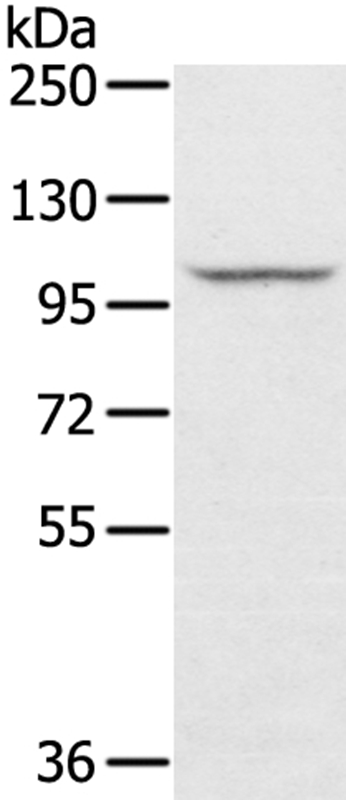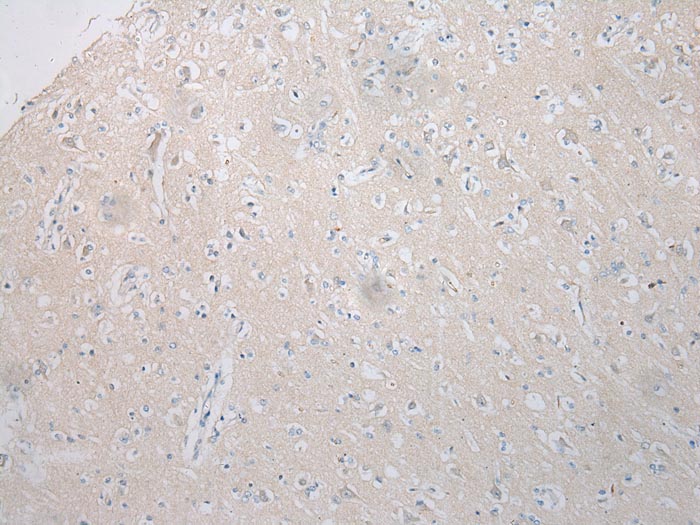

| WB | 咨询技术 | Human,Mouse,Rat |
| IF | 咨询技术 | Human,Mouse,Rat |
| IHC | 1/100-1/200 | Human,Mouse,Rat |
| ICC | 技术咨询 | Human,Mouse,Rat |
| FCM | 咨询技术 | Human,Mouse,Rat |
| Elisa | 咨询技术 | Human,Mouse,Rat |
| Aliases | DLC3; ARHGAP38; STARTGAP3 |
| Entrez GeneID | 9754; |
| WB Predicted band size | 113kDa |
| Host/Isotype | Rabbit IgG |
| Antibody Type | Primary antibody |
| Storage | Store at 4°C short term. Aliquot and store at -20°C long term. Avoid freeze/thaw cycles. |
| Species Reactivity | Human |
| Immunogen | Fusion protein corresponding to residues near the C terminal of human StAR-related lipid transfer (START) domain containing 8 |
| Formulation | Purified antibody in PBS with 0.05% sodium azide. |
+ +
以下是假设的关于STARD8抗体的参考文献示例(非真实文献,仅作格式参考):
---
1. **文献名称**: *STARD8 Expression in Ovarian Cancer: Role in Cell Migration and Prognosis*
**作者**: Smith A, et al.
**摘要**: 研究通过Western blot和免疫组化分析STARD8抗体在卵巢癌组织中的表达,发现其低表达与癌细胞迁移增强及患者预后不良相关,提示STARD8可能作为肿瘤抑制因子。
2. **文献名称**: *STARD8 Regulates Hepatic Lipid Metabolism via PPARα Signaling*
**作者**: Chen L, et al.
**摘要**: 利用STARD8特异性抗体检测肝细胞中蛋白定位,证实STARD8通过结合PPARα调控脂质代谢通路,其缺失导致小鼠模型中出现脂肪肝表型。
3. **文献名称**: *Development of a Novel Monoclonal Antibody for STARD8 and Its Application in Neurodegenerative Studies*
**作者**: Tanaka K, et al.
**摘要**: 报道一种高特异性STARD8单克隆抗体的开发,并通过免疫荧光证实STARD8与阿尔茨海默病模型中β-淀粉样蛋白沉积的共定位,提示其潜在病理作用。
4. **文献名称**: *STARD8 as a Biomarker in Colorectal Cancer: Validation by Immunohistochemistry*
**作者**: Müller R, et al.
**摘要**: 通过免疫组化(使用抗STARD8抗体)分析结直肠癌患者样本,发现STARD8高表达与化疗敏感性升高相关,支持其作为治疗反应预测标志物的潜力。
---
注:以上内容为模拟生成,实际文献需通过学术数据库(如PubMed、Web of Science)检索确认。
STARD8 (StAR-related lipid transfer domain-containing protein 8) is a member of the STARD protein family, which is characterized by a conserved START (StAR-related lipid transfer) domain involved in lipid binding and transport. STARD8 is implicated in intracellular cholesterol trafficking and lipid homeostasis, though its precise biological functions remain less characterized compared to other family members like STARD1 (steroidogenic acute regulatory protein). Structurally, STARD8 contains a coiled-coil domain and a C-terminal START domain, suggesting roles in protein-protein interactions and lipid signaling. It is expressed in various tissues, including the liver, brain, and reproductive organs, and has been linked to cellular processes such as vesicular transport, cytoskeletal organization, and regulation of Rho GTPase signaling pathways.
Antibodies targeting STARD8 are essential tools for investigating its expression, localization, and molecular interactions. They are widely used in techniques like Western blotting, immunohistochemistry (IHC), and immunofluorescence (IF) to study STARD8's tissue distribution and subcellular localization, predominantly in the Golgi apparatus and cytoplasm. Dysregulation of STARD8 has been associated with pathological conditions, including cancer (e.g., hepatocellular carcinoma, gliomas) and metabolic disorders, highlighting its potential as a biomarker or therapeutic target. Commercial and custom STARD8 antibodies are typically validated for specificity using knockout controls or siRNA-mediated knockdown. Ongoing research aims to clarify STARD8’s role in lipid metabolism, cell proliferation, and disease mechanisms, driving demand for reliable antibody reagents.
×